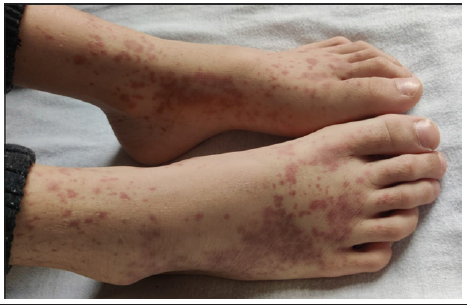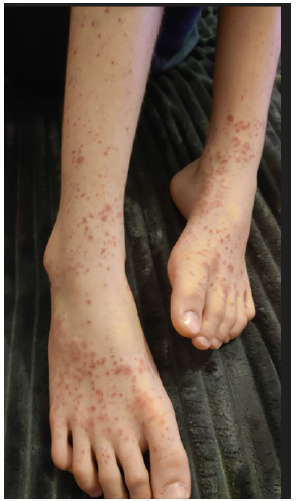Case Report 
 Creative Commons, CC-BY
Creative Commons, CC-BY
Immunglobulin-A Mediated Vasculitis in A 9 Years-Old Boy
*Corresponding author:Stefan Bittmann, Department of Pediatrics, Ped Mind Institute (PMI), Hindenburgring 4, D-48599 Gronau, Germany.
Received:April 19, 2023; Published:May 08, 2023
DOI: 10.34297/AJBSR.2023.18.002515
Introduction
IgA Vasculitis (IgAV), formerly known as Schönlein-Henoch purpura, is a leukocytoclastic vasculitis affecting small vessels, especially the skin, gastrointestinal tract, and glomeruli, with predominantly IgA-containing immune complex deposits, often accompanied by arthralgias and/or arthritis. Clinically, the disease manifests on the skin with palpable purpura, abdominal pain, intussusception, nephritis, joint swelling or pain. Schönlein first described purpura-associated arthritis in 1837, while Enoch reported the combination of nephritis with abdominal pain in 1874. The disease begins with a sudden onset of palpable purpura, typically on the feet, legs, and, occasionally, trunk and arms. The purpura begins in small urticarial districts that are palpable and sometimes hemorrhagic and confluent. Smaller groups of lesions may be added over days or weeks. Many patients also have fever and polyarthralgias with periarticular pain and swelling of the ankles, knees, hips, wrists, and elbows. Gastrointestinal symptoms are common and manifest as colicky abdominal pain, abdominal tenderness, and melena. Occasionally, intussusception occurs in children. Stool specimens may test positive for occult blood. Symptoms of immunoglobulin A-associated vasculitis usually resolve after about 4 weeks, and there is often at least one relapse after a disease-free interval of several weeks. In most patients, the disease heals without leaving serious damage. While rare, some patients may still develop chronic kidney disease. In adults, intussusception is rare and chronic kidney disease is more common than in children.
Case Report
A 9-year-old boy admitted in our pediatric department because of sudden ascending purplish spots starting on the feet with later extension to the lower legs (Figure 1,2). The patient was immediately admitted and based on various blood tests the diagnosis of Purpura Schönlein-Henoch, an IgA vasculitis, was confirmed. In the week before the rash appeared, the boy had nonspecific abdominal pain that could not be clearly assigned to any clinical picture. He had pain when walking. The examination of the kidneys was always unremarkable. The child was treated with intravenous glucocorticoids over one week. Symptoms more and more resolved, rash was diminishing. Nephrological results were negative in further clinical course.
Discussion
Ig-A vasculitis is a childhood disease caused by inflammation of the small blood vessels (vasculitis) [1-11]. It can affect the skin, intestines, kidneys and joints. Usually, the disease is preceded by a respiratory infection. The typical symptoms are skin rash, abdominal and joint pain. The symptoms can be gradual or sudden. There is no reliable test to detect the disease, but certain antibodies are elevated in 50% of those affected. The disease usually resolves within 4 weeks without late health effects. Purpura Schönlein- Henoch is the most common inflammatory vascular disease in young children and school-age children [1-11]. The disease always affects the skin. Intestine, kidney and joints may also be affected. It is often preceded by a respiratory infection. The skin rash is finely spotted and slightly raised palpable. Typically beginning on the lower legs with spread to the buttocks. Arms and other areas of the body are less commonly affected. Joint pain and swelling, mostly ankle and knee joints, are most often present. Symptoms are transient and do not leave joint deformity. Abdominal pain, possibly also blood in the stool is often found. In case of kidney involvement blood in the urine, swelling of the legs and high blood pressure can be found.
Less common are pain and swelling in the scrotum, cramps and signs of pneumonia. The disease has no definite cause, but occurs after bacterial and viral infections (e.g., pharyngitis), insect bites, allergies, and exposure to cold, as well as the use of various medications, including antibiotics. IgA-type antibodies also play a role in the pathogenesis of the disease. Therefore, the disease is termed IgA-vasculitis. The inflammatory reaction in the small blood vessels leads to increased release of fluid and bleeding of the blood vessels, resulting in symptoms in various organs. The disease occurs mainly in childhood. Children between 5 and 15 years of age are most commonly affected. The disease is usually milder in infants and children under 2 years of age. Boys are affected slightly more often than girls. The incidence is more common in the winter months and usually occurs after a respiratory infection. There are 10-22 new cases per 100,000 inhabitants per year and therefore, a rare disease in childhood. The prognosis in childhood is good, complications are only rarely found.
Acknowledgments
None.
Conflict of Interest
None.
References
- Piram M, Mahr A (2013) Epidemiology of immunoglobulin A vasculitis (Henoch-Schönlein): current state of knowledge. Curr Opin Rheumatol 25(2): 171-178.
- Gazel U, Colak S, Sari A, Cansu DÜ, Yazici A, et al. (2020) Damage assessment in adult IgA vasculitis. Cross-sectional results of a multicentre cohort. Clin Exp Rheumatol 38 Suppl 124(2): 155-160.
- Cristina Maggio M, Maringhini S, Sabrina Ragusa S, Corsello G (2018) Acute renal insufficiency and pancreatitis in a child with atypical Henoch-Schönlein purpura: efficacy of a single dose of cyclophosphamide. J Int Med Res46(12): 5285-5290.
- Li M, Omi T, Matano Y, Fujimori S, Kawana S (2014) The diagnostic usefulness of video capsule endoscopy in adolescent immunoglobulin A vasculitis (Henoch-Schonlein purpura). J Nippon Med Sch 81(2): 114-147.
- Güngör T, Özdel S, Bağlan E, Karakaya D, Çelikkaya E, Bülbül M, et al. (2022 )An Assessment on the Effectiveness of the Immature Granulocyte Percentage in Predicting Internal Organ Involvement Among Children With Henoch-Schönlein Purpura. J Pediatr Hematol Oncol44(2): e413-e417.
- Mohammed BT, Alchalabi M, Laskova A, Sun C, Lodhi O, et al. (2023) Case Report of Sotalol Induced IgA Vasculitis. Curr Rheumatol Rev 19(1): 113-119.
- Caliskan B, Guven A, Atabek C, Gok F, Demirbag S, et al. (2009) Henoch-Schönlein purpura presenting with symptoms mimicking balanoposthitis. Pediatr Rep1(1): e5.
- Miao M, Li X, Wang Q, Zhu Y, Cui Y, et al. (2019) Association between anti-α-1,4-D-polygalacturonic acid antibodies and Henoch-Schönlein purpura in children. J Int Med Res47(6): 2545-2554.
- He X, Zhao Y, Li Y, Kang S, Ding Y, et al. (2012) Serum amyloid A levels associated with gastrointestinal manifestations in Henoch-Schönlein purpura. Inflammation 35(4):1251-1255.
- Dhaliwal KK, Lile NA, Tan CL, Lim CH (2020) Life-threatening complications of Henoch-Schönlein purpura: diffuse alveolar haemorrhage, venous thrombosis and bowel ischaemia. BMJ Case Rep 13(9): e235905.
- Casanueva B, Rodriguez Valverde V, Luceño A (1988) Circulating IgA producing cells in the differential diagnosis of Henoch-Schönlein purpura. J Rheumatol 15(8): 1229-1233.





 We use cookies to ensure you get the best experience on our website.
We use cookies to ensure you get the best experience on our website.